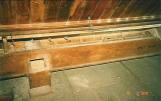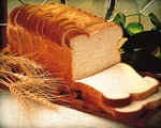2
Before the process of milling can be understood, it is necessary to have a clear idea of the structure of a grain of wheat, because the difficulties in the process are due to the presence in each grain of several very different elements. A grain of wheat is a fruit. It is a store of nourishment on which the germ, only a tiny portion of the grain, may feed when it begins its growth. The outer coat of the grain is the bran, coarse and tough and not used for human consumption. Inside the husk lies the bran, which has several distinct layers, with its innermost layer, the aleuione layer rich in foodstuffs, surrounds the flour, also known as the endosperm part of the grain. The problem of the miller is to secure this flour part in as great a state of purity as possible. The germ is very small; amounting to hardly two per cent of the grain, but it is rich in oils and has to be extracted from the flour if the flour is to keep well.4
The processing of flour in modern times begins with the wheat from the railroad cars being elevated into bins, each containing a different grade. From these bins, a regulated mixture of each grade of grain is used to make up a blend. This blend of wheat goes next to the milling bins in preparation for the cleaning process. The cleaning process is important because the wheat usually contains other seeds such as oats and barley, as well as earth stones and sand.The wheat therefore passes from the milling bins through a system of cleansing machinery consisting of separators which removes all roughage, screenings and small wheat seeds. These separators are in the form of metallic sieves. Perforations of the first two are just large enough to allow a kernel of wheat to pass through, and therefore oats, straw, and other impurities larger than a kernel of wheat are separated in the sieves. The lower sieve has perforations smaller than a kernel of wheat and this allows small seeds and impurities to pass through. The wheat then passes through the separators partially cleaned.
5
From the separators the wheat passes to the scourers which are upright perforated cylinders with large beaters revolving on a shaft within the cylinder. The purpose of the scourers is to remove the thin tuft of hair at the end of the wheat kernel, all the dust and a portion of the screenings. This is done by drawing the kernels against the outside of the cylinder and allowing them to fall gradually to the foot of this container. While the wheat is falling through the cylinder a strong current of air passing upward carries off the dust from the scouring.6
Next, the wheat goes to the cockle-cylinder, where foreign seeds are removed. The wheat is then heated and sent to tempering bins, where water is added. It is then allowed to stand anywhere from 3 to 24 hours, according to it's hardness in order to wash the grain. After soaking, the wheat is dried in a whizzer, which spins the grain round at such a speed that most of the water is thrown off by centrifugal force, and then it is further dried by alternate blasts of hot and cold air. Once again, the wheat is scoured; for a second time it is heated and sent to a small bin above the first-break rolls where it is held for 20 minutes before entering the flour milling process. The wheat is now ready to be broken up and have flour, feed, and other by-products extracted from it. The object of passing the grain through the first pair of rolls is to break the kernel up into comparatively large fragments and to make as little flour as possible. The flour made at this stage is usually dark in colour, and poor in quality. From this process, semolina, the larger-sized particles of grain, and middlings, the middle-sized particles are obtained.The first pair of rolls through which the wheat passes gives what is called the first break. These rolls have grooves cut length-wise and revolve against one another, one roll moving faster than the other. They are set so that they will cut rather than crush, nip rather than flatten. The whole of this cut and torn wheat is then sifted through a series of sieves, and the coarse part, which does not pass through, is sent to another pair of rolls set somewhat closer together. The sifting and the crushing process are performed five times, until all the starchy materials are separated from the bran. At this stage, the original kernels have been divided roughly into flour, middlings and bran.
8
The middlings must now be divided into various grades according to size. This is done by passing the middlings over sieves covered with various sizes of bolting cloth. The first sieve has a fine cloth through which the flour passes. The next section is covered with slightly coarser cloth through which the finest grade of middlings passes. The following sections have cloth a little coarser than the last, until the end is reached. The middlings that pass through the last cloth are called No. 1 middlings.10
After the middlings are graded, they pass on to a machine known as the middlings purifier. This is a long, narrow sieve with a strong current of air passing upward through the cloth. The middlings travel slowly from one end of the sieve to the other. The current of air carries off the fine dust into a dust-collector. The fine bran, being much lighter than the middlings, is suspended by the air current above the cloth. The middlings, with their greater weight, go through the cloth. The bran is carried by the current of air to the tail of the machine and is separated from the middlings.12
Each break makes a quality of stock entirely different and distinct in itself which is purified and sent to different parts of the mill to be reduced into flour of varying grades. The reduction system starts with sizing the large middlings and taking a portion of flour from each grinding. This is kept up until the tail of the mill is reached and all the flour has been extracted. The rolls are different from the first-break rolls as they are smoother and a little closer together, but they move, like the break rolls, at different speeds. The bran does not break up, but flattens out and may be removed by passing the middlings over a fine bolting cloth that passes over the end of the reel. This flour contains small particles of bran and cannot be graded as high as the other flour. When the tail of the mill is reached, all that is left of the wheat is fit only for feed-stuff for animals.Every flour mill produces several different qualities of flour such as white, bran, and graham flour.
With increased transportation facilities, large mills began to replace the small country mills, for by reason of their large out-out, they could grind the wheat at much less cost. During the last half of the century, or perhaps for a longer time period, milling has come into the hands of large corporations.
The whole story of human existence can be written and told in the terms of mans staff of life – bread! Bread has been the mainstay of human diet for almost 6,000 years. However, the knowledge of people concerning this life giving food is very meager and inadequate. Not one person in a thousand realizes, knows, or understands what is contained in the food upon which he leans heavily and of which he consumes large quantities, not only every day, but in most cases, at every meal.




